By Todd Grossman
J. C. Penney, Macy’s – shutters down for several stores.
In the last decade, Sears has closed 22 percent of its stores. The knock-on effect? The death of the mall – they are bleeding out. Those that ignored data analytics – did not invest in customer intelligence – are feeling the squeeze.
Canny retailers saw this oncoming storm and, jumping onboard, brought about a phenomenal growth in ecommerce.
Retail is bleeding out
Last year, eMarketer wrote, “Retail ecommerce sales will reach $1.915 trillion in 2016 … The digital portion of sales continues to expand rapidly, with a 23.7 percent growth rate forecast for 2016.”
Millennials’ buying power will soon surpass that of the generations before them.
Having grown up in a mobile world, millennials expect to be able to run their lives from their phone. Chat to their friends on social media, buy clothes, tickets and books, search for answers, and make payments. Obviously, online shopping is a given but, it has to be wow. They want an enhanced experience, relevant recommendations, an easy and safe payment method, same-day delivery.
Blinkered, traditional retailers suffered a huge blow as purchasing behavior changed.
And, do not think that because your brand does not offer online shopping you are safe – 81 percent of shoppers research online before purchasing. Consumers are checking out product reviews – your brand is in competition. I presume you have an online presence?
Role of social networks for retail
A study from Accenture reveals that two-thirds of Generation Z shoppers are interested in purchasing via social media directly. Forty-four percent cite social media as a popular source for product inspiration. Thirty-seven percent have increased their use of social media for purchase decision-making in the last year.
To survive, the traditional retail industry must tap into this group and learn. Go to where millennials and Generation Z are talking, and listen. Learn this new language.
Where to start
Retailers must prioritize mobile, personalization, customer service and a great customer service (CX) as their top digital business initiatives this year. They have to realize a new future. Consumers are busier, we want things faster, now.
Even us Brits have had enough of queuing - a recent study showing that United Kingdom consumers are no longer willing to wait in line for more than six minutes. Six minutes – time was we would queue for a good three hours before getting antsy.
Too much?
Let us take a breath for a moment and start listening.
A social listening platform hears what is being said online and on social media. The analytics revealed will identify customer behavior, opinion, sentiment and all that is being said about your brand – good and bad.
Magic words: CX and trends
Retailers who are already making the most out of social excel in two areas: customer experience and trends. Let us look at some examples of how they are shaping the future of shopping on social.
Do not be afraid to follow trends.
Starbucks sells coffee, just coffee. Not the best in the world, not the worst. Consumers buy into the experience.
Whether it is designing their own cup, having their name misspelled on their latte and sharing on social media – intentional? Bloody clever if it is – or using the applications developed by the stores which make it easier to pay for their drink whilst earning points for discounts and freebies, they are buying into the experience.
It is still just coffee in a cardboard cup – but it is Starbucks coffee in a cardboard cup.
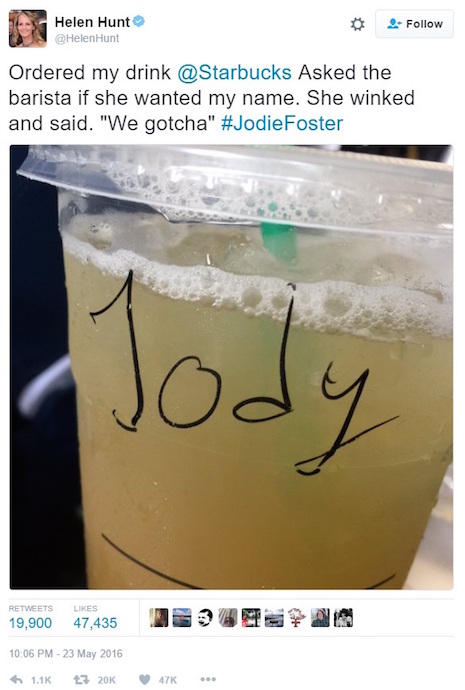 Name shame at Starbucks
Name shame at Starbucks
https://twitter.com/helenhunt/status/734837890887213057?lang=en
What Starbucks learned is that if you are not on social media, you are not being social, so do not expect to make any friends. The brand is passionate about giving consumers what they want – and that is not merely coffee.
Jumping on a trend
Visual or otherwise, your brand has to make a noise. A noise that consumers will hear, because it is something they are into.
 Not just a purple unicorn
Not just a purple unicorn
In a recent blog post, I highlighted Starbucks as a brand that knows how to use social media and wins, hands down. Using visual storytelling, its products are Instagrammable. The Unicorn Frappuccino – tasted disgusting – went viral.
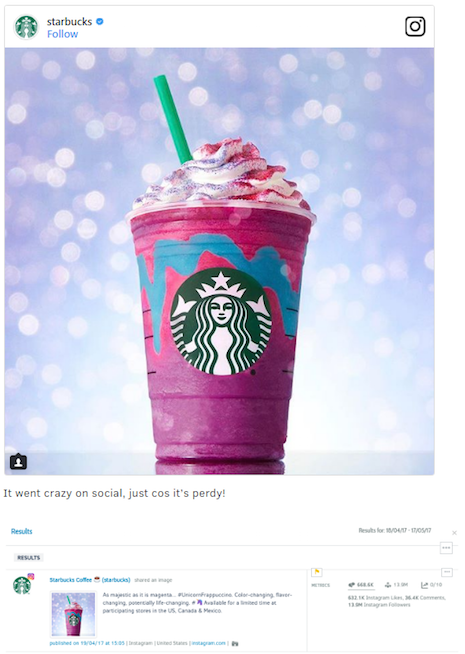 Unicorn Frapppuccino
Unicorn Frapppuccino
https://www.instagram.com/p/BTEWcNHjACU/
Take a look online, what are consumers talking about, what are they sharing?
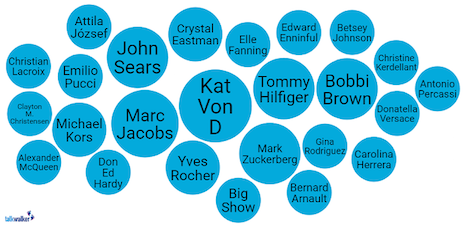 What is trending?
What is trending?
Improving the customer experience
Understanding buyers’ needs is the key to successful sales. A retailer has to focus on what the buyer needs and wants to make a fast purchasing decision.
Retailers are faced with disruptions along the entire customer journey. Journeys that are no longer linear, but instead form a complicated Web of interactions – and yet customers expect retailers to just be present when the mood is right.
Add customers’ banner blindness for ads and a strong aversion to being tracked, any retailer would be frustrated long before it has even seen a cent.
Savvy retailers streamline, adopt user-friendly systems, help consumers on their purchase journey. Chatbots offering customer support, an improved payment experience – self-checkout kiosks, digital payment technology and fun – you gotta make it fun.
Power of chatbots
Retailers are experimenting with chatbots for customer service enquiries such as “What should I buy?” “What are your opening hours?” and “What sizes are available?”
According to a study by Google, 97 percent of consumers are using their phones whilst in stores to help with their purchases.
Prepared to spend big, consumers want as much information as possible before handing over their cash.
Chatbots – complementing shop assistants – can answer questions about tech specs, pricing and product comparisons. Why not just look on the brand’s Web site? Looking takes time, whilst a few questions will give all the necessary information.
Big brands are already using chatbots to facilitate online transactions.
- In 2016, H&M introduced its bot – using Kik messaging application – as an extension to its brand that customizes the consumer’s shopping experience. Looking for inspiration, had enough of the darkness of Goth and considering the retro band T-shirts of hipsters - the H&M bot acts as personal stylist, answering questions and offering advice.
- Taco Bell jumped on the botwagon with TacoBot, using the Slack messaging platform. The bot – still in private beta mode – with a “sharp and witty personality,” chats, answers questions, and helps with food orders.
- In 2015, Domino’s pizza introduced “tweet to order.” In an effort to grab a larger slice of tech-savvy consumers, Domino’s CEO Patrick Doyle said, “We’ve got this down to a five-second exchange.” Frequent customers – suffering finger fatigue – barely have to type, simply tweeting a pizza emoji at the brand.
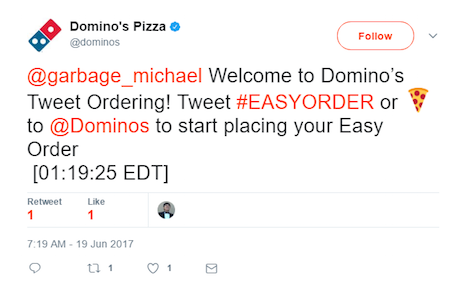 Domino's Easy Order tweet
Domino's Easy Order tweet
https://twitter.com/dominos/status/876670734524960768
- Yep, Domino’s gets two bullet points – and well deserved. The pizza parlor – or should that be tech parlor – launched its Facebook Messenger chatbot at the end of 2016. Keeping it simple, you simply type “PIZZA”, and guess what … At the beginning of 2017, the bot called Dom, was updated. No longer necessary to create a Domino’s profile, cheese fans can access the whole menu directly from Messenger, and then track your order. This embracing of tech has given the firm an estimated $4.7 billion annually in global digital sales.
Enough with the food talk.
- Tommy Hilfiger was the first fashion brand to get with the bot trend. It launched its chatbot on Facebook Messenger to tie in with New York Fashion Week, named TMY.GRL. It provides a personalized and scalable shopping experience through the new collection using artificial intelligence. The brand uses various bots for different lines, including Tommy Girl and Tommy Pier.
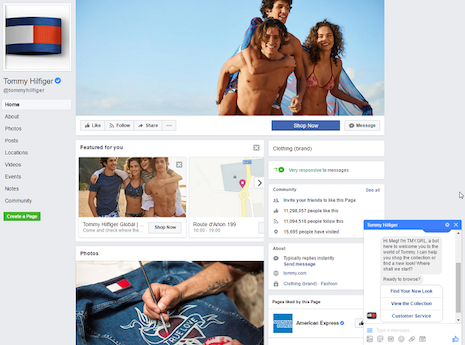 Tommy Hilfiger: Bot's up
Tommy Hilfiger: Bot's up
Customer experience is a massively big deal that is changing along the entire journey. So much so that I could write an entire report about how Apple facilitates payments to bring about a cashless future with Apple Wallet. How Amazon has long been targeting a no-click future – Amazon Prime Now, Echo Voice Re-ordering, Amazon’s Choice, Dash Replenishment Service, and Dash Buttons. Oh, and DHL delivers to your doorstep with one of their drones – the same day you did not click, of course.
First steps to improving customer experience
Know your audience
Every consumer is different – has different needs, takes a different purchasing route. Retailers can monitor and analyze this data and build contextualized campaigns that are triggered by customer behavior.
Check out the breakdown of your customer base, then create content that really resonates with them.
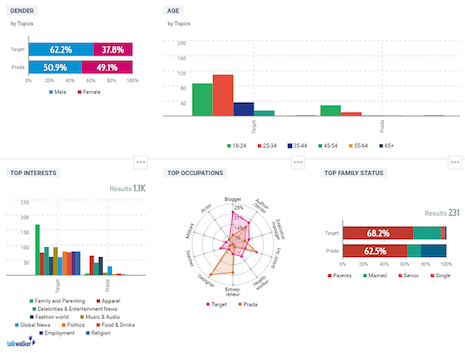 Target versus Prada - customer demographic
Target versus Prada - customer demographic
Mapping customer journey on social
How can brands make the leap from unstructured conversations on social, to identifying customer behavior - to fully leverage the customer journey?
Be more like a consumer and less like a brand. Walking through the customer experience and identifying the touch points where consumers interact with your brand.
A touch point being any time a consumer comes in contact with your brand: before, during or after purchase. Once you have this data, the journey can be optimized, the customer experience enhanced, and the outcome predicted.
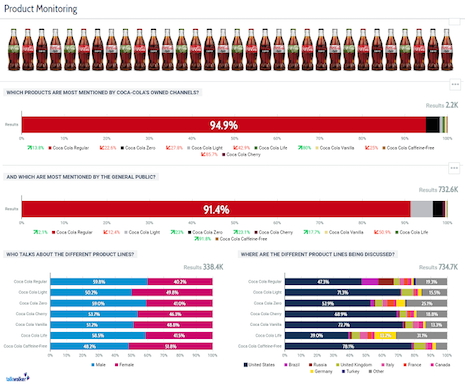 Monitoring the range of products reveals consumers’ preferences, gender breakdown and location of discussions
Monitoring the range of products reveals consumers’ preferences, gender breakdown and location of discussions
Loyalty programs: The power of points
We have so many choices, being able to skip from one brand to another, is super cool. Retailers though, are experiencing a tension headache.
Customer loyalty is a hard won battle. Research shows that 79 percent of customers will switch to another brand within a week of poor customer service.
How can brands strengthen customer loyalty when consumers have more choices every day?
Loyalty clubs or reward programs have proven successful in winning customers, and keeping them. Brands such as Sephora, McDonald’s and Starbucks have already rolled out loyalty programs.
- Eighty-six percent of consumers say loyalty is driven by likability and 83 percent of consumers say trust. For example, in a fair swap for the customer's data, Sephora's Color IQ app provides value to customers by matching makeup with skin tone and personalizing the customer's shopping experience. The brand is happy, the customers are happy and wearing the correct moisturizer tone.
- H&M says, “Say goodbye to plastic membership cards. It’s all happening in your smartphone!” The brand launched its loyalty scheme in which shoppers earn points when purchasing in-store and online. Earned points unlock exclusive offers, promos, rewards and access to events. Users also get a 25 percent discount on their birthday, and 20 percent discount when you sign up online.
Where does that leave retailers that are just coming to terms with the changing reality of customer relationships?
One important thing to remember: loyalty and great customer service go hand in hand.
Improve customer service
You have to identify each time a consumer mentions your brand, and act fast. Sixty percent of customers on Twitter expect brands to respond to their queries within one hour.
The same study states that a friendly customer service, could encourage 76% of customers to recommend a brand. Forty-three percent of consumers interact with brands on social media – that means you have to be there, doing social media stuff. They expect a direct response to a problem or question. With a social listening tool, it is easy to find these interactions and become more involved and improve the customer experience.
Using an emotion filter is one sure-fire way to improve customer experience all the way.
Filter for anger or joy, and have your community managers reach out directly to create memorable positive experiences.
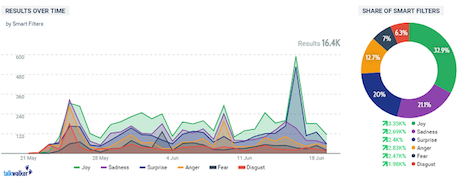 Demonstrating the range of emotions over a set time period
Demonstrating the range of emotions over a set time period
WE WANT THINGS easier, with less commitment.
We expect a personalized experience that understands our preferences and constraints: our budget, our shoe size, our color choices.
Retailers must listen to consumers and learn what they want to create a truly remarkable customer experience that saves time, money and stress. A retailer has to be our best mate, find our pain points, listen to our woes, help us.
Recommendations
- Customer centric. Ask yourself: are you in the business of helping your customers buy your products, or are you just going for the hard sell? Consumer connectivity and immersive interaction: retailers have to get to know consumers so that they are able to deliver a personalized experience. Know who you are talking to, understand how often they shop. Then you will be fully equipped to target with relevant offers, promotions, product alerts and shop openings to help.
- CX focused. What little touches in your store are talking to your customers, demonstrating what you think of them and making them feel special? Your customer experience has to be remarkable. Create a wow factor that will put your competitors to shame.
I cannot leave leave without a high-five to U.K. fashion retailer, Topshop. The brand created the ultimate customer experience when its flagship store in London’s Oxford Street launched a virtual reality experience in the form of a giant waterslide: Retail theater creating an immersive and shareable experience for consumers.
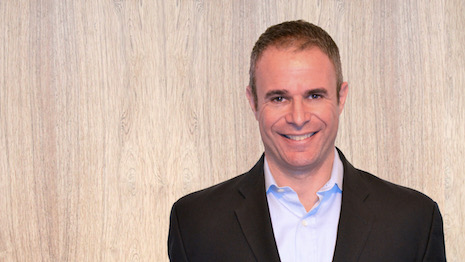 Todd Grossman is CEO for North America at Talkwalker
Todd Grossman is CEO for North America at Talkwalker
Todd Grossman is CEO for North America at Talkwalker, New York. Reach him at t.grossman@talkwalker.com.
{"ct":"AqxHMHW6ZezNKAqZtcFUqT8k0H0IoaDmRIewEjhdsjorQWK2Hi5sW4W42laVF4XI3dLWNRfFMf6mjdXCoHXLV1CCYfVo0VhVgJrvrx+7u44iqCu8Wc4NEl0KZ5sGG6dtr1RJruP6PRiI1vDAQOHqg99F7VQ7AXr\/pCjv3Bs0MMFk739VAEUmlwXjn5O+xw1kxoGiiNRn\/B+1XjWTR\/Hj75s9khD86o58gjWcJ0Y6Hk6ypaMJeQj\/pLrcSR0D+rdvfnclEMy\/mscmwYQABUDTGFgj44jDghxc1eeS2HwLdHE\/P7lRr0jdLXTN92syxLnQaRA4R8ss1z2csGwylxITyKn07dqAJ2xcEtL0qM8vusS8CAjQ2Aw2v0DCKkQiHlXPe8m7DArMIWBZOAbKmJb7CLDfikiDgnUnzHL6MRyi7OiDkDMvfSXdm\/55lG\/XzO63eYLm4SOFZiGXaBzj77YguxcvJh+u2Ir1NaSy\/lnfVoSF2PaosTLtN\/B\/bm5fJBdIDPpk+m7HnKB4s2L33Ft99kqzPeme8KtOku1r4uHJpHx6kwI\/+6\/9iOP7WMoFKLAAf1yrClV3gKBK8xR2OviMAb\/xOlrDG7O92qPPiUvr9IeB0tdvevVLrXqM6W70wrr8eUd5bge0jg3X7IAGxvZ2e00QFO5E7i2VDdpznVNDIqOu2hd1ZzTskl+oYndMgzNoEU8KaaZ28h2EuVKytr0IGb+\/sejstSm6biULoMuA8GYXeOOB2DjRk7Wx29DOcT8cHwPQjAqI\/mPm5ObtVnPbhtaPJaYB5jdLWPMLO0k6JYHVqoHO3oogEXxdiM\/eYgZqcj4l25SkDho8+nXonwZbm5EzEWVmOkw3Hp+rseS4PrnhjXS0tjKmuZiIU0V8eLIkW3feQGInR5TDkX54nsJODbr424zu\/MEyEZNIkwegN+SKeYYy2G5IZOuasXpaAp0n652EMg9yumugSOus9VjKhVEmexWaRza7wPBYXXMHi87Yqoph8jJmiZ4APLL1CRPEauHbYuCIzJz5NXr2Rh5JLJmjdmvEL1a8GPIMB6+kvFeFSaxTwra8OnfQ9PWr7ZO6N7LxrTCv0kzh0UMLTiVzyk8CERxnnKCGjN\/TumXzq+jIOoqm7n4U7IbA9ayJ\/UvtcPwPeUUkyMm0+YTjnn6f3A254MiTRo\/R0BsQjR7YWJNyWHwHXJYu6m2F79O2ZIUY8bePkVjlJsK30y36JNwOVw+0KzjKooRndVquR3hDAX1GsRTqYPY8M\/x2lBONtdT0f5DSAm50AKiC8wzzwPfwwA4mQBpKUjBBfdpZ78kjZpKCIHXHOtlSTXKC1WISv4JzqGif\/gaUdA2pVZNrZHceA4AX5yjJZyRKtwgXWOuNOxAoDoPQ0tIs9IglREHNyuNnOr5LXWFJ4ojm1YuXRibB4SzdB85DvPglqn4RHXhHPqv4KURPWH5Izjrcovn2pcXRERRTRI\/8GejINSK70sfHuK2qMz2VmVGDtZ8z1F2EcUqJ96MgH1zXU+zx3a1kXHyVL\/5kkygORzeGbWr7XIt5y1gAIBhLXeL+oBvP6YVNQf8S1u9ujvhm127FA2AvzQAsi9nO+bMYtdhzXLjp2Vf8RBzg155pwBIlf+fsQBhMbiUZVRAr96c\/nLcjDOG28ePwCU+bfYVp3j4+pK8h5d59HLB+\/abD64EXJulWdZYxasHwoxfbd7f1+9cStefaiYtlF80wJSIaaBY72QLkpAG0GOu7sC7x7UXIhagnsWnNaqt5pkwWzzQ5\/NNocyDEgI8YZlo7PSX8iaHqFdUwUPcEexDITnWY9ZbrGz\/JrRC0\/GsFAT7URXprL+MWMXEMSKCyblorW1X8kb+A6Ym5DNAlde7Ef4IgLBcmDHS7PKDi3sh9JGnoGIv245SIz5Enw59n4HjY1uv8PywB6mISmvilK2isRA6DnB4feTQIfLt5UpVvJ8WtedRIV+IVc2BxTf8psU2frbxWY2rRDLjzuAAAawWE1r3\/blsoW562wXSlfCH7o7UWUhhrIjYWNtLMRlAxisE7MqusOAj3QJXO38sPq8YQ4FaBpiZo12bC8dbFFbnvhlTmRz07I8mxI3yHJIw3c+VnCg3SNGRJsBLvFWF5XbpLtCl\/RpwOvVmmfiEffPw5v7NbrJd88rtLd6qjx3ttBPFn1\/bVbTizrN2oYppSSasJ3DRIeHwpEJObtnKiaD\/MtjG3q+zj7CM6R3c+l2zQyviN0RboyueL30I1EVbekIiyJjFZRaLJjWfSxm7l+w8EsYv3o6aDOws5hju3S4kGw27bSQ\/L8NlBErGFncq9dJAAtjhDcNtgX9p8Z+d50xvj4c8aA7vlys0qtPsagUee2dXRUw1q8Dxk2myfhIyMbf9D19KnyKE1HQIF\/fy6m+bnOqvpexpW8GQhOM9VgVYoBdxxbT9ESifEpJXNgUrxWfwx4u\/g6rgTZInUprVb\/5u6tqWhPde2N3SqadtmBYbes36JTr4cdm3xYlzdKmIuiM2u14ZmgrbNTZYt8R5EWAd7+01H6bUElswyaKPJ3B0vXStWnASUjCqpO8Qj7luE6NCp\/lJZ972d\/FkyNtWUJzCTkeDuIUoEqLiLQkHDtedvmv\/899QmhCYJZ0dUyeI6tP7Lipn6mHp5+yGEQQq5SEBBh0+Di5NeGbt\/vELSZoh1pjfRwHbbhIji+xqRbInoUDXBy5fX9Qk0iENx5\/j3II3Il+GIwMZNTedaJSr3ThPvGK6dd8f3rJ6+kW6i+Kyul9C1MQp4dnzX0ty\/urV+ONhI9s3HyOaSnGUatL5TAPvW2kDYvNbAqst\/E1A06RTfAt8QktAOMC7MN6by6GuMPaQd8IEbB1bMTdJa8HWFLaa4ZXkCYPaKPFGb6VdV7W+1B\/QTSpJMRJEdmGnn4gQ3PY4WBJ7+GrYUHxhLomiGs8KY5LIkuzQgobHhoxyqYILhRCI7844tUqWK4wHiIRBlhbgDvh5wmnHKLxUr0RFXt1XQ2ngaSDn3dlUHXwumgnpU54Rp7PPDqQM7+hQDwRyr84+mxTG1JlyIIGg3U1mSAksLZUhGUvQZkenbz63TR6X4OuzfZ3qFekYw40H3KMUBUEazpjvj1tSCUNXeYtspxljk+CGXDufnriK8eUjvVMTmovRPdlfkYJ4b0QBvKO1s4cFseWZT27sYsVOaSoMsIpyTnAf8UE3b8J5e6fDTEeEGhaIDV\/+4zKTiq03NwoSzVjRh6MslP3RBNMcqkn+Jo+4Lemyyqw9fHFBS4zA6AlCTu5TeFDj0u1rRajTYmnXiL6bkUDBP+\/yAL39bN5IfgNzg455BDEuygXHa+FTNtVoUuayrHyd8kVvdxIm7cgEMnlpQqZDgLeR0D5GxFycazX30\/+Lj\/IjwGchaTjJDqYH6yXMdkqau43SYbKmjC1Xgpdkg3Mo\/75wJYVau4dy3siWraBd\/OCk6BppUQtaQoWmKVRrZt0bciOCct9f106Pq+6F\/C\/tJ1tjdrrYS82duSdt8vI\/RS1xSABGc6Ey\/EJOppX89dzc0+NcWlBJdKc0vzJJ8S42UavFmQMFgUsbtH4Wt9MoXJHsPezEbGYVyJd3rk0G6EMsVjCQHsQeiuLpwYiED+q0o8ar9nMgbf\/eP7tjempnabNIcP3OeC11ApJoxiygOYADIFFHt8ZfP5FsTznXNH9QJnKz5baejP5ub3sqBhXfuOk2r4C1yiuB06dEXT7fhl2nycl9Eiy944hoDx8vSJqLbGdLPY6eXNvJnz8OMoHLvDONl+Btjj3RfQz4KPuXXZMhe967kbPMC6Lgrtq6oTvKzwVPb7ItfDMAQ6NR0msM3EcM0uxPB3h5Nkght0z1qGyFOV2dOlLYBesHAtcwms9dZid41FekXrFLpFvn7BOBZyX2rVtgoE3O0YmglA8d9srL7UDc\/oNCn3KVNlUZWBr3I5KtYDLgC7fmqEGgxcgZiN\/ddXGgaGy6E2M5HnmjZ1ZM+dwRiOToCyC3cD1txVCMuHDGKr7dUFcA9qqcTtTBrbeIgZWje8a44uRmE0DxUHcetqSlOw65L7mVWPOCCFHKpW5\/m4wo\/MeJoWz7fH1JzDX\/C\/xNG7+fc+Yq6Q6GqNEZShpvGyRdilU7jAuG9eOOjjY9dg5c8zHNdHJsmz0njh5kDOoNEXYSyHGrsxSlMxe2CapbQFxQKmOS7xyIvTD9Hv3v3i5a51aEyc3+dyjOcB3jjeC\/JGq\/RS5Ym2ZKG70XhYcqi1hqh6AGSkkUwr\/Dx8oLkNLxII\/7onv9OjMQGm31Wtkk3O7PD6TKxt9VkQ5eMFnAsibdbudKB\/BX+TjTbJX31ylGC+Wnoo\/YZ397ipazBevSdaB1C9PeJaTxqCTqaFm9vB8FRs0trWI\/DfSKG4jIsfGOm3NVqirwmuNXU9IbsshmBZLM1LClyiYD0M9GsLt\/WfdGvK4+\/0m7srNPeaaBggt96zkAxdrO5lBpW8GRBTZZxnbviwwo+\/kjSD8Y8q5lQdkmqASyAc352gKlO7pGRKOBSmC\/\/IWdzAtiND\/2VzBAY6rUZWlCsFoQnv6cT9Y0ZluFI0Yr8bl+iWHoFg3HlnHBqv3VJbzThpxR8cf+OUwsWW40yZaJiP91uNUHi9Z7rlpjbXbnhFeQfAmRQhAARS4ZecYEj2ztb60mG3ZXAe0LVAuTaU2lSdPy3tNk8fXYvvow0ROYVbX95e3boTpF\/GZBHXbElVi4dEOAk9uc+llPjBOaY827V5xPlCePj6Mm0+2Ny56b\/NUt3ssISbf6Pa3+q7Uk\/t89thvkSZTWLt5Yc0LEJ5BLcEgxeyy2N+HZlGaKsA5koRI0VFWI\/Yhn4hFdrhlsBRymCw2D0799vkGhZF69QoieXaOdyi\/6KN1n0ewDjsWIyCdEYvUyx0ioN4OaKoO+8Iv\/MWB2EJQnDuN+qn3bd\/eKuM6PTFixX7VZ1xtDy+zwYdHujiLQ1zgqS1WIKdYA9mxvCadnlYcOVi75JG4wXKhGLmvnB7owu6M7WgaRXPz\/vMd9NiNlLeyq8EEeY65qp4sDDpHdlHmIMqJejzYf3sxqBGKMr8jr0CUL9RVVJFkT20hOWwaz9hr5XQUNL3milPLL46GH4\/FZmOyr7AGvMssMlASJUQk3nj61qxqulGFJghzXRJhZWd1msDRVPPVv9qadU0xfZhqENeioVWxZ1cfQUV\/lC6JJHT5g\/VkFMXtt4VjQ0F7GIJca5h6eOZzqh3iZpR+D3WBf6YZzykF0+\/zMGiUqlcJycuIiTBPyxTtErTfZg7U3ETrqNFXx3lSyRnMYwEm1TLIZ1WJodMnTNSBs4fjDI+DwhoK+hTYAE1OQxR1\/6djJCb\/syO36XrmMoi80f+u6aSnSV9zCAxWBMdz09Upz3cMKhSPzEM5ESm8HRoE8qga\/unUg2gmPv1u0J5XNPj3rOiPZr\/WRZf\/+uzlxtHdzvViZoa2iNV65DzJoYQywqA9j\/MmM3SY+e2v0U+uBoDBKr+PayrxuKqz9tk4qGMlbQzD5bJpezWwv9vH54B4r1IlbQ8W2JgH7H5pGEswkhwtwABh3gEj3sMheJg2IbqSxnsEZcPB1fq3HnIDgq5HpyrXfDbNpo\/jIzSbQDkZmUZDRocJnitR1gpx9Fu+jhP126O3ibeT9rlLU9TDKe9DFTLQKvlDegujpiYdduTb6gNHyukaEtVYYowv4zBN8l9Ka\/6v3\/\/s9MfCmxDlkmmiVOn9urXStCOPHTGF4gBWt+vnWiRyjPC5gE9gFuaFDfEabOk8PLKEj4I9W8WWOqZVYo0NxJIacam8F70aRKclvkdxTc+9jEc7PAbf2W13Iqg\/L7hLZRjobJR0cSC1EuxD3ZpyPG2H8z9XlA+WPSjYzm\/Wg275V4fTg5rOHVNZeid12uttW6Z9cAOcyWVR1gm54dxY+1ImO\/P9vm7cxXVdihKGLjQrbDuN\/2sZU9vOef+a5DC5XhERLmrht4O5pC2C9FAMSgLjnBRkkSHPK8Xs29FQa7TGivcrrcsT0Yakd0V+xXC5AOsMZRW9W4fQp8wHSmsd9PtcrQc3QMZQyHycOIYSy9QoR5DQ0r3\/PnsWFfegSizGnbs\/\/rUeOoZTHyw5LxwHVNnKDkQ\/nsmJPnsz+Wp3tWXMfZeGUGWRMn5V80s5rmzlMkz6xUOtFv9LAwVOUXkjGRRnNXR9UO4id82vquoISqHz\/FZTycMU4FW\/BmsMNSh355UDQudayRWI1aef7SBazctuhU9zYFdQnhmezWjT9yA8tRCb4djVlOJn0jxEyO3Gq9RUIxypYPjtm5ZpB\/vEqfeN0+JOs80+h9h8OjtiwBflqhdhR28U0FxOEvpe6eCn8uj\/csbU2bFgbP2HPbpwjBTb9CV9d8EX8X+Zd3f+j9EEO4ZPIJM1WoWFU8DPvBcN6soc3R5LEQgOikpHcM6nnmlugNWPPuKbWN35HyEr\/zDQw64\/BgFWZ6OVoNrcpqjB5f8K\/Gshd6HNdnKC4QLlb3iQ+vFkMsx1iSeF8Tv1PgcTj+kJxlmCW43uDejbcXUoCTkAwLbv+eO+pywCeIZxcNqa+3xmxnpKOGUDycLR\/AQJD\/rH9wYVrQckWxjWZBmsWXqW7iB4vOgSIxXiLSwZB0DPxMn6uOzsOHSsNh9HFuYuyBQDKnvv1cIMm5l1iehHWIXxmm7ercKqySirh4IwVqGEpawr6q9xZeHPbcragk2mPj+shw6tRKugUdcB2cbQzV7w634DpiFhwTZdwM8kTGZlmkJqneJo76yLHOq8tQZqBNI5gL0bJdeEGyUM48bO\/I\/s+PjRZOI9WclZzIVmL+1NP8ofc0QURD\/29+MLYStoh3IWw9Gu64htxiP+VOsZNUOCjNSzQqYNJNM8nixHaWLUT3EJ5oNIUdI7YURxz8XhkptKAL48d3oYiy3OYbRsrtBr\/p2tSrHoBeiKjgDdufJ+mJjjd9+VQBV\/uyiOtYYVQXEOIoJsmNYf3vpVIJd31GUmaiakXo4yPvaVvN9XVSgL4qSWELE+FD9xIttaDU+\/p7W6zMsW\/hj9abRD0D8xKZn7lh8EMo\/JA33iM1mTcKay9S0fpNWQJRCQb56poZiai7lT6Npgc6SPgZwhXsADMj03C5CASbAvIq8ZztBN8gXQsqCVty7L\/2JezbiBalXOq+GJqcTF+k3JxyvJpISjI3GNIjLCIFqRvd9WguIkK015EK+L7+YsYW16gF2BVul2vbZJLtrVgWJHR5jVUG73oARnfEkyWKw0OXc9vmUmT1JLAPqsRWuda7sL\/78NtQCR0pEEHlggILDWL6FUR6WEvMZmmx4YVDvgIXO40+0LTiBXxpKzKzG8t+9Apqy3jpNsmuHbZrWpLoUKowsNT72dRFozktqCj+ILeTb\/5iQiWHiCEECHOQ7gKFr9zsUR18ZHjqZq+nX0dkoAijscKl7gOQn2Lqc9OgDGoR1IYBEjiV9KcCM2c\/LtDfDtsu92rX1rR8eyrT+N9J48ZL29Vq61wLXbOBWvnZhrZ1W0pnnym6bs5pl0aeCYXKbF5UbHgIWIRwUntfA2rTmMdIv0YKKmYB9wFdKFIbtkie7LIdz7eGbPTg8tzF5No6U79NAh7stHgr80DxuosYK9XO4qzn3+pOQExy1Ljh6jRYtgDpTF95mbxYj2pbfffitiTuE0e8PriK0feASoSJSpGIEq1dOnNrRVgfPxDFl56sulSVOIunIll80RZBaIkcKmS4nbc9L0G22icUrkinNTsgb2dZcqXSL9ZDcyYsXk1AaYKgnr\/Q0FmcqNhQGyV++q+O6dIeDgywNn6BwW42zOIPI2GlAut373irczoAEvSttWkCWbICBrt33sUFxUXCII8tPZiIn6D5LGIhGA1lWoND2WZyMARGuIVugFwIb2Su3GK2utK5ZPAagZEt1cfyLVSElaN2pfCArai1e+Bf5Fv2Ocz4qsnL9vfe5xiCHcu8uHx4RdfIXHtZTh+8yS2SKZa6jQbvy4I0IaaTGA5LXRZc+RFUxRqR45AgA626tindx71QC7CgroT7vTqCiQx\/m62mHTTEHh1QYr\/tFgOJ+f\/1ZaI0SnEY7OCQf+6W+FUAVZJhIdmFyqe2kEWDnjScCEMWh7ejrpZtCcmTr\/PPwTs41ktoUH7nW2+Ef1BjNeZqcwuDvRRNzwKwlfWUsEgvVfZVNhosNtvsaM+C97blfWv1s4CDRHhpSzsQdvjzMiLPcUIEanzhqDHKe4rIXqrrCBzkAS2GvZTh6VoeiY7ofOBtvoBynci5jzQqvC89aj+3YM55a9\/bnT0cx35TMR43TEif82K63pHJ\/V9DwZnzb2sV31uNxlB8o1dmse2EO7a0TzHuK2qJjtj1hUz0uVewnm+468D4\/UxOA4\/frP9KTnPe9PqUeU4m9YFl1Hp7SiwqI+6IyA3SxP06DH5tcMBXpu8ogpkRVKK7USjrYg9\/0OnTVNy5kxYuigkbxqraLbFIBkbkHIgp6c2wsw7wSHD9vfU4Wf9UmPKYWlkYP7xDoJIHQFrtgcIlkYTzK\/VqKdEvXGgQHLdTnwrbwfQ+mM5DwnKaYwzEEzh2vGJiP52ynns2ekUQbR1wMfC11xCK38ivXfqGYNp4L3AJ77G2S4U45cEVnn+YjYfHjYwpaSIT0tshjhceGNVGI0TLw90e19fPbpTo1MCm+f6CuK+sQJAoPUfLPFoANC\/faeGOQebT47rTccGT8Td147defvvOBKKQUIUglo5b+TSC3hRIN+K+ivfyXkJ\/QdSLboQ8qLzyo9ag+fZTVuuCEHl91mccOxW0hyNZ\/8InKOrsaQWWR0Rism6ygu02h8TZ\/J6ktnfoMSiFVrOVn225H1dcLYsJMb40clFb\/jJgOeCsgy+s\/dKhfAI6IMykN7DR3Pi41PXtQLsGAslXyZyQjM+huJhp4EOs4aYpYTHZaBoq9GCjBcckpVUsxOLUBffXKTn3nbgxwnzX27z5K2W0HXDd8a6i7D+MJG9oIJh55K9JKQhEAeLQXEb4JdhG1gOkw2Vqqdjn8SlbQGkDm4tNUcidle98NFpt2XR7hrIhQmdR1SdXp71tRVs7Y\/XcojYCg59dxD\/PcqluGmGDySLpZqRiftY34JBR9aK5fMXIN17uA\/FiQ+Nqf68Vrq3xUUJ5SfvbUySJq\/tDNvl9qlvKIeIQlWnZodAna8yKsh0\/ThsAVzglADzvymd5H+vNSCdXbvu7MmFJG71iyOKkmjyElqEtz3OXzdQPAjg1Oqk3ip7Lqo6nQX3CP9D1+1UFYjNmU4yER18gmzccSwQAApw+naEtugn4HPLBBQkzvWfyMY9jZ88BU3IYMa0IDmboA80qW6XvK6PWWHiOa0Z+TjIuwGbBQgEMae+8stWc05J7Cvsx2tmcaZIAIpC7LlkZH7wUTXxKrs\/Urc6Pv7X8nwdygq7PYBs4tsqudHrKWKJ7azCHTkJ8mhWqOzzjQCBNgJaKiKHpVFv8De8Lg46ILt1S+r5RE2keuQ4dDHSfSKptRPhH3pjYloy6ZfR9aeTct4kAKeOeFJI4jTFNuOy9YhJU3QJ8B7qAQ3PohnUxW3lvNK2XgjM6lLdYQU\/1I1AlSiTH+07BwnC\/apvOJCVG7UxolW6AK\/2C4CjWJX4yS\/06pu6HvzS+RgvfB5sE6yOGbQvvChNCGbSHEzHhdvLW4nvMWfpITkAaJ4raRzQD2zG3feVKgKkQNfz1GMhM8Pz0dDee2sRo5am2K5tiUfUFF5CV9riTTzjSgMUl2uG3D+LatigFZROa+\/eywk\/+4A0sdT+k1n9svmlAuKrURAXq3aXb9xIJ5OIL7pxEs6263LM9xYv0UyeixBCfV7Ti\/ALQyRWQjchA5mMMqdm5zWF9s7W6whQvPS7O2BPsSe9rCaOtmUDHn5t54VS688vuCgFvczs98js\/hs7S4ZuYlUbE3c\/ncJkCqO9qoWai9N97BU9RwvflzFYeW+25flskPuj52OcOlgW+Z8oNyN\/4qBa+g1FjtA61GAmyz9R7ifjj6DcEhucFaVrVJNju\/khTs8aLQWGUJ1v54P1zoRkWM\/1NS167rQ4Ollhd3nj+Le6Ed4drrY9nPSVeq0ccSyhDEQVjXGUWRHJXwjyYmeVg4uhQowk72qgqCciNyt2qCQ3UuuwpPRfGMmlDqcMQK5led+JHmLk4rEHsuj94sohI\/3WlhNsjb9yYGc5fkYSvrusR7LGx3nr+KN8PJoyoQaB4TfAvaxSlmjWBcmCuYUca+exOh5hqtqNuifM4KAwtGVjCGvd91f1z9Bz4+3sKFWEvXDiuxRV6irvQcnQMxFMWF28gWRMSWtZ1RbXhU0ucqBf50uMnzIPCgA8rDvsLdOd2LzvZPtxcFnN7j7MiKNVo99BcOp7NcJL4ml\/PMaMApNZlbVNYfTUc9G\/1Y98xWqSi26gBLE2OfGFwc7riv3EPs19mt5E42Q6+HSbAO089uOv4CQ7ywweMpi3Ekh6yZPuw6RUvDnfrFl1pa0q5UuF\/OSNgrBb1qxGhYQv4gicSxIpF6gEWfCbN4jzhPGW7Wv9g3uIxD\/pgWKu8DN4qChGwbGD3yqxkc2rlOKnbvJ1dK9woQCcGG9CxnfbMeiwnxGNBgq56460Ss2DVYiXS5R0NZ6yeMDPgCtE9YW\/PRIFqwoKsAL44FWzxv75w6qD1p2ACN2GrnKjuCJtl+t8pOFNR3Fs+dTE5vbpXzTCh8m8upCnq3JIrWNXXejzNdreIcOzdHLaezpXL\/H3UfDUqjlivylxA2tVLFEbk1WBk5luUU0dY75fePwNRedv+F26r3IfKLowZsmcmCzZXbDnYsAbSVyJwwXR\/Qru93tFViEBu+yhIiE5PPPXBIQqdH7pt83d8QG7ta+j2CXhYe1Ca6OMZO8tnV+4awRKPL8bJigYcf4q8rIs0cK2RWV5wxtN4AaOBACHg6JRcNB\/oHkMui3obA5DL72T3tfycw7IQAJkQG6bwMEsu0BVHeqPu7yiS7SAEhpDvisJ1ibSOnst9Rrubazpv6yBHS9XOAtglvJ8cGJE9l9aeAzPEPYcjqAijIDs+F8xsyVsfxUjRsMuMvHqavxbfz9cFY1jOgvS8OXIA9B5JuDNzZEKlvnEdXPv\/mviU\/oKqmkVnxCzNtQShSPVy5IBBpSLD4oO2plWQnIRMVj4NaCpxpuZa0SR+OjjHP0AAj1ywcooWKDPnkFHmuo04ubRZ214ew0s+7nRWXNzPFkbk\/bSJbd3LP6hR+1H4jJ1pBO3eungeWncm2w4P2YeDxp2UoPQvwfs80Qi6VNfkVDJQcSqJP6Mi2AH0Qx+IEcBFGCRo4giDU4XKJUv0pdPYt2tPy34iHb5i+i5lat3g2FpXv6\/O\/+00VfrZnET9iubE75YcUE7oP7e9hdcIpeM6uDAXNY8RRke2x9q\/rYmAW9r\/K2dRVSQX7UPzHRxksEgJ8cR8t2S66ZfcTQPiSWKAI3eS4\/Ps4sQdSz1IsI6VDuWZxhg3pD8eaTQM1jVrFJfjdsY232xjeuKvDdk5a9nhszK6Bka6HCelfGhO1qI8WBMiNDvnStgUQwT7WaH4rQXEImRDObUVMFb4opzqdK0DbV5D5MwBKYKjlnYLgIQpLK+Xp2tDoECwSg15uTBe7qTqvEXJSDGqG+SMxAJj4vLStD+qjK3uy8kvTZDolqlXpQLQ6X3UryDMg62CgRvbO4rFDQpKQFvSzTtALeLZihlzl\/QHiIviCNnlPekKg7jz3pWi4cGGIfT7C2RpRGp8AFpzF9fzlzl3YT5YUkUeOGAn4CnH1LF0pSIFDM0FJlOvv4+oRSMuHzoztto4k5UJmEWdYhS3OySN2Ip+vu30OXY\/cvfXbKdHYaYYY6BRyZWCT67E+3S51Z0vkLxriuKY1TtHfvhuLEqLp+Egw49Qjc+8V+gpQ6YMcpOfVZAmTJWeLHxED+pu8zTkhEwYkPCuYzhs8\/T9QAyRkW1AAIFKCrEGH1xTQJNhdURxwY2bRk7EnVHfmfXmmJLZbLpGpi\/ZbISlMQ8k2+2PVuLo\/MbuZpK9bSVvomU+yuyVQTgDdhwmvlVaphAd6uJTvyxvuTtKjhjusTyNNx2hG1HLkbh2ZmYKlSL\/V4cbG1r6ui1b3COykxwSu+Mc4Xfe0EpMcGQQAmwRsK\/0wUG7eLau0+lAeL0s\/6kdxN2HrxvE56+8eamHJbZmhj50gGgS0qSBtpFue1BUAxy4\/Y7dPJNXRDP5owgXMH5Sfg9vMDCADCg8hIz0aPvkv9UJRBuHom26CXHKAgcooVAWNLGEFuavsJLEPZrl42Gu0a2xwqmXLeQPtmLv3bQs+mN4oF5dCOqayGriva8JGXrVZbQtoZyi\/66fEgWnsH0pLV+e5uaRLw9YxOF9RpGSQIgdZDiCsH0wMtR2twPY04yLuCQtHzoxDi7d1gij7VbECMQsVfVQrxJP8OiArDHGcHPXSSWsN4sytMgbap+zpIxZw+iDEIC\/Rg4eF4Ir+ax485lU7Zy7UkimGf\/XPrapiSVwNUJstIiwGow+DDnbeqpM9uCpSmTVP9+O3wYt1YrKzlz8Dg8eXS6X1fBff1qQteSB5hiZb2H1dLCx0gRonpMMEo3v0\/QXAW\/mh9XXqm90tQcmBEMTYynp1MvNP9KEi8x43zRPfddG4MP82tj4h4oWiZTezfxgYTr51c1a\/PeIctBGYr9DJIRe3UarHMZ9K+iXo35cSIqdZmscE4H+t5mcNS\/yOopmrlPyuKt9xgkT8fpRr4U\/bwSdI2c7kvuOyng9y26KgceA1Lc+4\/AvpRBXIwTP\/TaV1LG6qv8MG4Rdjydb9PkbZbarHIvxx9frLkEi3D9gCuJXsAvcnyDJQKC3ZpVn2hCKauyU8FuHYQa0vL9MVxJcyr+\/sLs4pXWxrLXtrwP+bF89q1RefHZC5uk8K\/ZxQCGSZerU18TiZFinlWXLNvpQTjDblLSVzmGaw16\/jLmQSnod\/\/FigGf8K8NBsZNtpIhb+5nU3Yp2WuyIER+CGehTND1gNzuoWRpGYnsJ9WiVMmGJq9zAz\/RLuZWAZHH2YlnZHvwHNyVfGJ4ZeqbOVVytSfBCG+umLDoPKF79x\/cUEOkHU1CunJpa2jTJmYPXqGOTnlUgvoFMVzBnoZM4vsZl8EprPcgJkeFyoX2ZiWt8dOnBx69HEEU3CcKfHbmzFP4IaXzuFNPqmEK4N9yPWs1ZZpDx1\/NtmaPH1t1qemnV0Hl\/nWODhYhyCLMAClzuWwXUisFnHKQlEi7ToVLdgZfBQ5A1VQoU5NlPAjrBeJtqfVazfv7W6qNLzP4qVCS\/v4MSO7sdKFO76aNBerd7bmQTja290geXYtSrPxmRfYvQKr3wy5gCdsDB2ou0gJxGeDX03BWl\/oiid2QPJgSV8M0YnBNE\/PiQ+1BMRkJvjtr9tbAspsymwzGeOeM+XlwULB4G0ICnXEiI0lUnYiT2\/SH8GVm9Woym4yFyyKScamL3qcta\/T7H7lUv8bVki663xXaSXWa+Vid55K5W+dlYEo4shRm4lNknjz0uJzZpMrz6Tyi80M4FVWsYJ8iGPghJvcc8Q3c4cNdIXGMlRGEDR+NXeLDCljdHNhbB18KZIIvlxgcJgAx5T\/GveoU5k5S5mTTYG8tNPgT\/kbBWtX26DGCzM1PB26EHZ7hz9FyCYm7W+Fr7NqmFdf\/+E6dRD3UGZiJSz+ySJwjG0ez9GQ9PzyfkLa\/eBR5m+3yapQHvaeLGHgyR6e\/uTz2vimoK18ERDr5By70aEAFphY\/sL4ppanUHVa5xqhh7jKD0PpFQMMIPJYfzJzV\/hcpz9ositBPCf6Zv3qhpGoo4VpuVNmrGEcwM4Mrd9ABx0kMqPY07ei6iC2Dhp6LxAQ4oHdpYGfmCrA6gMTOD2Tqo4uaWhESaxRnlBvtGlb9I+XQWIqbrpGP6anMfBw0dNL9nPIm3du1ocefslZAj3RuttvGS3LfgrlBE45AiTc7ZnvdXPHwLH3m7aKN7nD2Kep71mdAGJqbsJCeK9nEVjkTivDbil1Xn1uQT3Lg7pltGborid\/DWVWqywYAveBx\/AfEPELawUIpypc\/286vaHN\/gWoz42aBckx3pCSeNOJyReXoxskSFfE71Y\/mOG+yHQhOUy0OXjmIsSliKE095VRIIEa3uMuo6KZ+uCRmE3Cmrna4qHz4Z6y3krwy87QCN8eHlctEo+fRfY56+2BynPJ4h6LTPcbXVURQcg2raVGiWP9NQp40HB+uYS4ZSirOPEP970+opgP5MvVu9Z0nzBZrY1TWyVDejSQEDWGGGQbiimZapvFMOROh+wNmvTsHs9Ifzo4KKBgvsjq5oeU+jemoEVPu4BnVjiCddRcR2NZL0pHqnLdkMa7oJGe2dZ9dX14nwQzsgoTmem07ULGvdhA0lk6zKec0LYEBq8Ou\/1dAxWzkXfH\/YM+RQjBZu\/3v4SeT3H3XsUI6DryA6ufzdAmVnsgZIGvmMlm4j2fUtB\/PT\/tEWo+Y\/kzDH4JRT1J2SQ67L0J6wYUvDjCByOwGgLs49WH8Ek6z+m4Mq\/2f0REuLo1yr7jjlt+ymLiVQj6yBod9kGllTwVjmn7qSRyiwNY1rvY6u+J6UWr4KoaxL2ZCzCfYEAbHLnlrbIbtA6KVVFcx\/9Z6BAj3JA74WVVRxo4euBkCdh706d1y0Z8pgXb5\/mQDvjF2A6ZzK1GlnUUqQQYiz7IDQ9Xm+lWgEnyeCTR3gcUIyja3+7N9d2FQO2oR69rd8+SOW0KWDe+pnYzZIOpWTPe49OvTIOQVo0P8OsAmZPppjrXsMvjivCk6XzYnczCCsgPDq1uiKhk7voiRX5NCB3rq7FC+f7+4dHtl6jX\/W8ZxDaDnNZtlHV5EpIKOtC9YXbS3cN06lmxGjstMI7wSxc2QwbZZBCVgqJynmd9opsG4xt7OWfhH186QuqaH1RBGLRUC5tHMJNTlhSUlNQNXPkKAWTLkx4F1NMUDUL9PK5EMeFW1lgqgh+HxDEDojo4Z33ZoJSm+7LEeq6B2DM1NO9OmMMDV2qI786M2ozKtlH7CT+6HMHQ9piZ9xmVrz\/Oh5fLW4+\/R493xuK7CT6HWCBJwEMJCSwjox1O5Qfljh98OTU7aNysSy5pc5JgJf390wx2bz6LfoBRfJZb9q\/BWCV5WSJaPbTYmJlpn41M2xgQEQFCIKfkS0by3Ve9Ar0H5RkrEX8pZjCBPLSH9Tp1vH+l\/Ly6hVnskAS6xKHPYzztlTx5C40Bz8sC4ZPBUoLZTPW42HggDhdI4NU5zc3+925Qt5r\/n9NCV4nJj66SzoDNkp525sQ8vXOOUM4FEwwJ\/7Q4EJ7zYNuvyfp0H+NC32Lb3hYk1xa1hRadeU1OODk2BtIm4C\/bAPNOsCyLLLXc8fbJ7Nj0V8Was6lj5M40N0ceyv5vAfq8c1SjIYyZDC+hBwswA\/JF0YHqooIvW\/c7Ik4T44grEBb8loBJF\/RsXgjfyQyja\/d9ifRKYadYRvBWOX34AwmH\/ntG3Gh5OddCBEYc77tNzEyrI40vl180cVtm6C+HYHO8vNNCem8kupTJlvdwza6r4BDWMtb4k2k3RZK\/\/\/iXK3k6vq3DV3xTsWfwkComg+UqPA3RBwkQmZgytayd6Tz3W4IYGd3fMTnobyASge00u0zxPaoCmaQeNIhRhpqFgDtxPmQfLHccR7W1jL2O8th8Z\/CG9UJqEoPs2oAqJnAurRTKNXsPDHUkeMG5oXnzoQGXyls\/vzxVjPoZaAxxK6oq7GGV0FVAfTzRG16MmI80wEhMT5rUwwcYuNixkxS+wMlCSte4Ke\/FTuQnAWGzXgEs8ayoo347+eN7iHZuHnYPQqDyEicX8h5MGZN3JPbWz9UtCledQK3FKLjNW2pWiTBmdMADZGKG2YFo1nQGuXyRxi3Fnv8zXhsiizefQ6oUq3ZJ14q9dYMDVy4mGgcKjeBnUkmOkJTlpJIIw2rBkcWsW9dTwxUOV6Imob66R8AkK3L+4ee7KgaQMbbvvwkmQhyPhdUb52d\/jzgQNUHafTMBXSbWjog1uuCBoPQqarPXmvkL08IyGWsRr5qLmjnHVg7Oj8AFvEIVwAxskLztB1Pz\/8paNv+8\/G\/FLpcvSw5hviftdkpVkQGWWzZ3mEHpZXljq2W2pBCw2j1AbivRFeiHtG53Xe8mFdku98p1YFVeUc3EIy5BAMhG7nOXbzSpr8T+bvpi6lf6dWZ14\/FMGaeeky2hly+6ngF4ORGBcalZQxX8oYwPyWI4GM37a8gTp71SdPhGnw2HWnCBMTJOxeF2zQd5TrfK1dqF9uvmCpiqBIE+Ou1Y0SWR6OzMYFpolTq4L0mSy3JIjmxvFxraBP9NltZgX5Cwy+rx84OrkdrBaDSkkkW6U099MKhSiN1erTzb2A7kUhjnxs\/oIaR1D6OslNQURnQt\/K7nWiL\/b8jTSjS3CX4ftbiyRhOhmTsf28QO9d9emXTOWG5yHDKRoUdASqhkLnpojIDCLGrJqACxvMRNPw2FBHMGGTl+3pSs7zIuCogISgP8yZgQXW9ljEkX3LpmhMvjab4XrUlSHRRhy3C9ZniUd5ocdM+BW6eUhBIAx\/+UqG3Ozdfpb9LeB6Ud5915Wf8KyzGGLoo12gSYPhxyAVo2+nQwUODUuK9lcNLCHFoDEiDOtVFpEW9lpcxEyciXWnNykgNByWAI1G2N7VT50SkUgH9dJTDDYUwqE9YtCTdTAMLoHU\/ztnI2LRL6CN+Ad4Vy6Nn0PpbROm\/8wlYZwmXhe8O4kmqhIo8whVONqrM1cfigqYVTvrRHXb0iQr8kmW33kLtggxRJUBnmY7I0ceo8n3m1m7D9bfVoYKvxsV0iV1gC9axm3Hy9pjM3qo\/W04frXkoMEU+fKLpS5cTa1aPdoI0BDRydmD01czpjuTrOoleIIK740ULcTqMm8a9Pjh5o8qC5KL3wLqyOHeulUh0xcC532ABLgOOvnXU8DtFfFiryV73f17UzH1GTeOSitRBxkQpEYoNq9Uh8GltlcGb11iKRZXkRvWdSeHWxfc1uDMKdKRrTc3VcRehFBMZ7iF2DdqaK4vi9ANNBf9Dgv53umu1cgTlWuetKGewW\/dOMQoAZbXJfNX\/NsJDVFAkFWL9yQLJX2dv8lF53b9Q796JE+7RXFuSyi6CNOPWeZUOuxt5TZGM3SG+qr0uCsQgGNjq9EdoUkm\/2hO3CLIGrFlmVZ5B4O+ddIT8isZk00Glwb5ymWYxvN8+sYjqLRZPrjQBUuMwlQ+2uvozf4uYp3GwUtcju2\/VEq2K8NMjY21J7YIKBg5Yu6ZbYLdvt\/Bj83XVLvhggevR4Ru2duiPidK1003hT0alUCqkmBb55GWmSNXbGWasrdYiT\/BSrgzKWztFz4BNYROGe9jHTlHQ3voss3\/edi9SInzTTbH0H9k8lvfJmWYtu7yMD4+xQIFmOIqxIz7+FBW7XW2giDsDXUKVZu6cfiiazdKpf\/jk2VGJUnhzWNlPu7sJWW+fxvmRMfJNw7H9M12sGk6XSZn3A4an3dtfW6RliVwRw4MA+iEZsxBjp2zIA0xKLegi3A5rP4HP2MPlXLw+T4utV5iVo3M42YAP\/+dhqZwDO9LCIvtVs9yomyHsUtZsMM1E6jJ6cOU4puUkUlEaJv1+4kATnKaSfkbJYr9tif\/ECrh+A6JOKC7j3mdQHtDe3klRDjbVlsiXmsnGV98v0LKRxPQx9r8v+CLUcLwZmnaBjAS2p9GMGZFKpATyKMQWCy4fcW1mBBNtw6Wq2HDYCnJvIGkh15Op2hHBP6qENIeoyk0REdmFXPnaF5i4M79Gdi\/unA32NqXdaqM8XL1jTLAoRfHccR7\/bkvQzEtEc56N68R+3zsHB+t0X7UsaiUNTqYpyM6u1pnS9Jjt9aTNbxoC40s\/PqQLgZjUmk7hzdPXMPgkC9pfd5wqHhUw2Vaalk4x7M9ywS9LpVdchkuZznicVyWD79\/+FzzT0DRKKrTuWmr+Ngo69qHjWC4bSBDJbDHKJSoOKIUNPcjhhEcFVoWFX5BXRzttoNjjyc+khf+YPhSP58LOipuSh8i2j3SIWrI6a4fJizgFXXMXEoFqSMYCR2zAEwFFuT2Kh4okFSODXw9sQyoxWI\/vfnw0QbwPMIbdALyj6Ug+1YALlZ4silb1OPx8OHOu3AAXiJyCeNbkaHw05XCIIDamr0aUGlTNfSjrBAhQ7kyfWPHcY3YnNz7bWADIhwK\/t6cEA5Nc6y83ukwXngXKNww5nxAtwVFO835b0loUwts2HUG7STNsCN7VY97Oaz9lE1dAo0ulH4W1hEdZuE33M5nhWkgnGfCrOWtPsYA7ckWRgLxJ\/xkvElIbiE+FNc0TsupRcOYpYBpFbambQehEW8KUkxTgVbHlN86PAQlUMejVKhsNLnSUXUnOOhGONJ0fc2\/fx4vXNf0vtOAP9DWx+JHyOcxONKNYR16bGtLfpUgfmSet+5n+U+NWws7F1shRfFeR4hKesPqAM3qX4Qgft9RZgHm6351KB4P23wRZFhQBs7+zBQFjtN1T8ikq1SI9bOGOV0yNxlX3n\/\/dMWRrFezwXTb8df2Ex0RPIKTC\/D5\/itamTBAkqtj5BKlSqqh+KM12YXVrkBXj7LQqzWwPcGFqkoRmM0rPo\/ywFUEPYNO+EsZz2UNuTm2Nfh+AOezh2tVfb806FQHZ\/+fmoM+7haTQ2XvaqbgnadHP9HWcT1BDi65g9PxejMAST\/ZgVM1wg5tzQmw13ZxbTliaVo5cXroMZypPd2z91zAts8O95C2euM3tm9Q\/cwsVloPSnyFFCv+mCWI+jOVndSfKaRODS1l9hsvIVsxLUEvnX+lMMKpakB4VYOx3iM+nYJES1krnBbxsHJ2lTXBIC\/ASK3uKALXddRvOFRKPX0haZ4ZD+bcOPS4G8I7uehGsW28Zr0kYmOOeyYG5B816eyftyZmyzEQpUHia+pprJ3cnW+hsXm3ERQAV4eh2FH32ch2HlmVMxA6lMeJ5PhbAuy9tI0sVEP7Xg5X27kfjSrhpefIULoospmVj6\/Ijl5Zt40Uo2XgD6s7KPtGKWgD3oqip+ygR5FhEtt5gOPTrCoOGq478YuuZTM+omH2WpzL2O9W0K124l80X5pr+8AS6R8r13I6OFTXERaHH0T444gOSptgYEpRCFytin8FWZTNvxs1QRiMGXPRwd3Bo5iZnJMicEtQfq3bg\/Pt3k\/YFYLP4EqmmDRQJpOdcZXUvwewwWrWCRPUAZrb7ggPHFoDLLBU33FEqDLR8T++NUqvPFUj78fBUQ\/ZTphPdCPmJXA7+So2khDAT+uGVe4YUu+rm2bHDSnmf0kmUZe6l56zGRVsSuW8rnfQjghBJdTZ4EtOiKQviXBN5PdBE6MlAJ\/W9QiZzhDPk\/yJcnonau8FKXm\/2ALYonLKmqmpRKRAbKtMZZKutHS1hqoLrS4WuQKlk+jv9Xr3udJIAng\/WT4Y2Gufsfqcw2\/g7fSrcGiax1DoufLttyG5yJKoUh3C5CxveAfKQT4bgfoyjABTOzJRQnBpJzZ6Lw3lkcgkBKfVsgTMwOIg6hWEBS8uZnHoSSouXqz+pmLZFt0TFqjK3yrvr3mFDEusdYMOH82zbiOGkIF6paqlt0PP24VgqViZPEF2LPfk+s07hdQurel\/Xo9vJPs3JjwG4yoKwwFJjGe7rGqrOWJ+MBOTKAd9dS1Mcx5YGc7+HKKCGVMvWImmowxPrhMSDzzEwqR1DbIPEnAkOlnyf2uLjjc798DMMb8cicl66vDfyA3lLz5H8CLSOzRBZ+AYTth80GViTJeehF1Z2VeLMu9jRJRlZXfABOu0NyrX2oZ7nXXSb0DL01had\/RPJF6Hqv7WDo30aY9zXchrKp1Jnma2hsxXjt8nBB+PNPqqdk3+5+m+GM5gZktwSAc4+YOp05FR\/XzD2HfP50Wj0tjnDHrw4PdOmt2cR0x4YyZX69DIo5G1bBa56a0mmLLyZgcbj3qdIowrtBQKC8x1A2eo9Nd2owLfze0hWTamjw9ssyLKCpEEmL3JgmEHmjyzQDFC+Q461gobnny7kNjop7tdDQVQtw\/f\/IHeSUX0gXqv0mKb4FTOguc5ZSjuafzQofsEuSpia5\/or1EpqmqMlahVGzs1TpWzBx+MR+0UeA+uapPFhxBS6eWQX16mGbUlCmtpPYFg\/XgmzhjlFOAnRHSu3WPWKpzGVVZjxJsR9ZIZMQJYXIt9osw57QBb9sL4hSoLmXPpiR+Ye\/ijEBPHedUtnPdiqaUjMHXOTjZu0OrAL9x1JU8yT1U6xSYmtQRx\/9GFrhXncPiafJ4q8\/yRs2Wvz6Su70oGHMFVpRi0q0TVJrzm7rqsNySAvllQfhNLTUPLuHZg2g8qT7nJRtJmtRKOFiuh7+BXtRvfjDkzOmo+jeX4iXZkZg6jzCz9dTViszMvN9XEvaea3\/ecV6T6j3h6tAAueUgivIJyMRfxWl+VKgNQNjOEg2A4Ad+58ZQFB+5Hsw+EWJwRm5D\/ekrIUjzxpIOTc28kGECVy8sC5BvdHNEy5VYRWhSk4sApQS7dPWAeACJLv\/79p0kgqO5XBo5fWq89leyXkkT0q7n8dAm46Ue5l+dltyvRhSDx8XGe5RtYDC3SUuBIm9BMhf5gpRBtMR0vlBLuc8PW0n+9ekiJy05v0mxa0jUeZ9ZQ\/dz9W\/6GcHiw8FDQnol3s1BdvhSTXxhoOM0gRlJvQalatGokib3ptthaI4QJkgzr8hLITt1iREzpR9jsFIa6HDc9ploaBNjrM02lTzy90GYZbYcvhoCvQ3Hzfk5TM6543r\/DOsaz1Ld\/IxMgtgTmKHG9CpGCWGMgebSNIjpDnGEmoIXYRi8OAKW1Dv2QUilGeqGeTSHsmOySIGEizoy8glsIeeRcjhwXcX43m+bgOlftJYWX0n8+0KUfi03+WFAGfeUh7a+Mvas5ByooBq6J9OWG1tp30Iu8ltB2sddNU6QmjhvWvdYi8GIer7n\/q39ikCTiLGzXBKBEk8IcVm0PK5ddfp5dNeUn3vMkUa0yIIS3s0KZu+UGhpM0eGW2HmjeHmBs9IINsgxVpKrE8gqzM6xyndHBtvoS4xC8gdaCVErw5R6N4YTumFdAyNW8R4rJRTaOmkudw6It8l5\/96xc7gknBY30LNDQ06t+43TNWjsUWhSrnJt91gdPIRapL5EE8huihmHlxUcwCVUKu0zwrXbuQ7SrOaikCAlunh92ijfOXNosjcZftbjZNPymA2Dofr4bh+oD50sAEVvHVa8SdGeWpjB3rbVK4uEOJjyFMuXL7dS0YK7Djq0DThBpZcG2HfZ0B0eouIursQiZbEYsUxFPV2vvbUePEjgsIiwiukXxFngHKIkmCFNvGYChfklzcI3LlC0ZNRxcBrejErhIpe5TtSd6Zvd6Lo4XWYEwWAiQjxjHjPVBUuLhye+6I2XwACuidkU\/LOHr\/WqBT45x8PphKTKUND1MhTXFX5U+2vwJTAUbbhkYHHubRaZZ52TJZObYvhRRcFXGM7mUCtQHrHWBxy3R1wL6Fk4phgRd6U58Av7CU9tcM04YN07ErDtMVB\/1BtNFVnkb\/HSvSCL9mXvZV2dSs4\/Y3SqTxFR20BeMItDRQsfBI4DzRWnCJdLcKNmNJwj29025PpBiJHTBxD\/FSJwAE+0mL74BzS6sKWoMGgsTNOx\/aEyVjLj5JAlmrz7uMkR9g1XNHbcz\/OVBdrw8YIJaZngZqBLurNfy1md5ZmmzxYZ7QOErZ+sQOIWJS4HQhV8hYrHi+JVSG53NW7nozkXON4a4iYCz1pihBx7vN+U9eMN3Fj8AY4mxpJnhOapfxcGhwq+\/gG5LEC+PIuhQH600HfQi0qZO0ulk0Q8IV7p5nCNeLUM7LnVtOLu+Eg9msmX\/QW1Mps7EoGMcH6DTkKKpDGGLupeJ+S+0lvH2qVyvGkYUipwVWBIJ4t2cTi2nAlhBwb\/0FEiDRTwnRfLChNCVDIvKORSzAcqGLEQ\/B+9xV65AjFi+O63kLa+Wj\/soHshR1dZzifDjPTWPQsiHDZAAPrmBkauZhTQ8GTmg8amqMWSu3uta6UdFcocYWGCuXX7tZMTezDNZjI9YSgSI2PMGTtkB6GRRsoYKVe33Vb30IIWEkeRSed\/x4STmwbce8QGRLpBCjXrsibOaR9GTkaoD25lEczCUWra9pbydxOEpN\/Ermz6AC6zF\/oeydte9Z2Eu+x4YpwDobJ1K88VvGMBnLmgiAJKIetEvjU2EKAoWtMk1OA8g\/tEz5DJtC2HS0fAlBahZDyYvSChMK1DOUZMbNjCZ6HLsgLLAgznvpxUyacHsxs8doGCfVbg3Zli4IzA9qa3BgIBxF3royb+p1BTZnWtGKFUkhH\/xbLc\/kKaZn5U\/DbtihnMfRBnCWwaMHMNareWri8nzzF1300xj98froDXbeKD135JHuTYBqEZHeNk3eYub70rSS\/ikIUtKs6UzvsyMo8Fdw647cqveprXT2m2vsJe21QL7iMRBIrn27k03ECY+T75tk6e6BuzCxmWWy6vY7AkyvbClvjyEOh7Bk5jr6pznK5y6XWii4yjbe+BXHxnpVYpMuK50hB+ArGANt3Dmgn6oxStR2vF5T778mAYvNMB51FzIEzIyfpHAtT7ufJA+yLHk6yyglpN1JkyrSieVwxhjGIgowNmySVknUHCdDouSTXzSGyXMrFp5yQPShqRYCWUNCAmiIbZldhH+\/ExEphJPKoA7u\/cQjHU5s3dy8TH42DqVIfMT7szzAgLlePSq\/narEaT1\/mmugeWlWbYTK6\/tk0X3RiMJ0yxAiphhMQR\/FNcTPb2TelOGUwCXw+IFFF0xoDQaQbVQ4OF6Mjq+1UofA0vE7yM04zNfXSYqcN8dadETtWMkWhjiwdLZ8713hgufU\/Fa6NKmiAw\/Q\/2WBhZ2X13PirHiZBJ9t2ylEvmf4dThD1tzz0RMG8Gb9lbjjTTT87\/vgy2r0NWq1NxZ+cPFUGOiVYH\/BK7aU4xh\/40wk6tqI8C62jBcvGT0pC\/OlYbgTenMb6fXYOYQ\/HyNCRi6a\/2MtDAxDOJK3YExvNa2acu9XIvi1WfEIHYvmVZ39UIyx93AI\/jpIUdAVoD2GmL8FvmosbT5JikQSHKuiJCDjmds1Rvw3B8cal\/tPEeOYS4qA4DhDs58TBfk\/N0lPj00bezLbi9lP4sM\/11De8T5JIMe4+xCwZlg9ZfhohGDwg0W+WR94L9HeHtFzs+XRSBmsC+yXq7SoxdmCeqli3mOmx7Ov85kNZeTg7KRaggCG106vQFvPXLy1BvvGurpgjmoFyHlsuXiV82Vj063CAujp078B7jROvxUd1pvfGHhjMj66plcQBIMl1bHlM091BQnHR4sfzAFg8IrlFW4G2KJj2tOkS1V\/PN1FdoXy9V0pBLL7rkx6wLrKMYTYaFEj45YtyPjlGqO6n8QzjzXjrAgooqJXdwU\/FNW1ns44ANoKgchvRceHtFivHW\/yjX5baFMeZzjlrik6scXfs2YTAi\/pc9l73OhIroFKZqV8HgiF6FK4603rEmPZauIhl5skYRKcAYKtj4arHzoszGDGblEV0YnfOpV2Yb2I\/1Gd0e+98RXUdGshClSrilGWyT\/\/u5SSoj8DfaSvYX2C4YshIZpTEaqsB758wmY7OQdOsT7gtP7zHzyO4SZs2K3rzjmXUSsvOJOdVIwgyastjv1hfgnJnQwygg+sh3Lxj3pSyYy9ZlBnwxcjLbdGksP9UXXQWCpyxeqhcZxF\/ebn3q627HH\/5hE0s226Y+w3pCg4oS1+fAj\/Pq1cAtXRgWOn5\/O3FIFaCqCQK2Q53U9j2d2DE5Zuud8ua+qpGkfb99GNgCRsR\/SqhShggiKGb265cREM3oxhTPzukuP6s77AcdgffaqGhbe4q0mfi1HmdlvX9fuRIiKTptywlNgbqbgcK5yeVe57+tC6DBtGLPq64lYW8cnkoPXgz3Atkdy5\/QPIJ2uF4Ff\/JgOPm8atgi2WfEN7nuuzYIWG22H3sxUfMwiQddOijod44DavThKtlP08IchR3oNqApGlElGbtWZ+eeTgI\/x9FhN4cmlft6L10QDWOEswzSc5eDDDRYVbydHaCbxoojABXzcf92tDsoLM0mR+zjEGdPHmb03tqz2SiSLocWEdcE5XqmMqaXgMZPLLk8FGg3jWDfMlCe4skVdMxEL0eyc4hTUFj\/k\/N\/wkaYAV74cT\/smebakHXHHwSzHoTx1CwOVoQnIKhLLu2Cofq7V4PtMkIDrMa0iNbRz9dQJzuXoKAp4vL05D40Hf+OgDeilE0a\/QTv+JH2WloSntiR7ouYew9dXNCYVXlA8FFYGo\/HPWltADoDV\/ES9Vo7SDSwqyX56StTOo0\/O2CD3T5+jMwK9U5IEVHkpnZYqe457cj\/tKDsf9O2ztgadVhybjvpTt5wSL+\/mT\/KeyC39+x+a2MXwpkB8DhkTeCcmdOaJRueWhcQFp\/oT7cI0X3xuWT9jp\/NmcM8exjeyRXd0+4nj\/me5JAnieNHwYb8+3se+emvT6jK3yvU5ClI1KSNQMtd8rQwQW3DBujz2APW9X46jRpKtrYv9AUDlmghwOCV\/rjKe6vqZ66slK1aX2eoFX+tcwIFlKGlaxy\/\/stKeFw5pnUFqOHRK8R14OwLMEd0LUO4mx0vtIe2k7HED6P\/\/Nxc924JmA7qT1tv6Cx0KLtmxZnFSVQKOGhsXYrr1sALiZynF5F38yo+FvEdKKeC7elk9bZB5GOuN+vuP\/U0Hr+PplnZxhQxYYQnqbc\/++kWz0Zskq0ZIzIlPJHm3NEwYMqHWBez9Qn1NwmpPK3mqVq+98K8z\/2w2INLwWSedpADnZ53T9BkTpAn0GS8Og1+3WNTwNygBedGmLdJM+joPwcE6otFjiPHU1T3qS\/SQ5fqoVDe3JxVxVGHDTFK7jabiNSV6uhoSo6DyiM+gQNSEb+H99SoUPaUcERWDnUthxXgKxYx6E3Bz9NctJg3OT7qkTRZP99f4IWXjoptVDTMaEVLGYbhoptuMJNfHCoIq52dXZqZ9ep8lWUSPIgMObx8h4GOKiTYqbPHZHg7aHaAcl22QFdClGbRNzDFfYTaCuxJuoOD4tVXj+xFvtIlJR2u+ht5HqbV3hvIvO\/bxE3\/uNPPZgRFNm\/6HsAFzAFJArFy7iQSpgsd0W\/UyxOrqLO+nPavk8DyHgk+WbQxlgwCYOf1\/ucO+fj6AyMA0EP6ZkUgKz9NVbN+6d1eIiqpiLIU9GHuLEiFZ8NSM42D8x5q5s3jiNaL5Ge6yD5XjiDmEs07Qrz8DNH4zPHxt26ap7htuOsF+JU6ehx91EoRMwctczbyWNQqP0WjvjTmj\/usTTkvbVcgbILAPqQ4GLhd4\/OGzn+AuEqCDseZ+rjJ8W7j9N+lD3XcaWOOUZD5QqfWCHNuPzPWxkozas8dYXoD3nSvg20po2BkQanwbCufYYyjJV\/PVLWlyngP8SP5bGGathf2Fk+PZdzm7L+xJiZrbxI70\/wOeSikpEOnVVANclXQSUtifDk8HnF3bClEtL6elkUXmW8zHhsxEtQlc4rkad5RtoZO2DW5u5IDmWdLCuSqM3T9zCUvmPtR0Gwb0oUFSEwGWsfzXmV9NhToL\/vrpr8vI04hQpbDjXzSpNPrN6FmDrCz4I8dga07HkAIdgOqPo3jUVZ7suPyvc\/toNxmUhCtBEdSg76VYI50F7Sp78NKtCz91iVAb07SCI5RvvXx5DckfDPjCgM0sWDAaPxaUFcO3kY8JrZWSEgQ2\/0iuH2TifpI02EAyhJnvEu+edyHBBMWmF+qwovCJsSqo+5AEcAqWT5rVVciUhhGsCfuNZuzdrIH1afF+BVLrm+cwyG7R9MQRN5HjYvRBfaewSdiQXkDyzzmWorYBMmqcWy9u0F+Gk8Y6tQLSJ2OgGVbxbZvKYf9xSl5BUJCloAbZeNb+YnUPb15r++p54lSaDRoJeAJ3h9d1fSs1fynxLkxZ3wkWzHraDoLmycN+F+zlyMkWxDWEGBVDoKBbe1+NT1sqvN\/NdSxfwCVT7rK0Zonbb8N3qX7MyLAxQTfiNrCBZUAwLfyMnOJkUZtSATP3OKMgXhQX+zn\/hIXvFjVnCmEvl4wey8quxBZ3mcBXKqyCOmajrt+wlIMYnWDZttTLyWhiM9oWR9Pl4rUMOpIodIPqkUm6niZN5Kj2g++XBIRxDvtvxg7Pg1yuNcon+d736kKIue7vj6BYHHX1NCaVUGLbN6dhYq2xx56nhJdcJMg3mqKZEIE25HsAOxMMROneKB980PzCOQkYlQ9IuL8D6RX6d9sW7kP9RWpuXwhuBfiZsW4NNC\/qpV7KY+iFf+RI9oVseuFwumtv5PPC1uSjdtqsZpcoxuDb+keXp+kOVbLgTSXiogiggMr2qODcPrzIAgyYlnfYRzM\/vDqC+suRH6aYpviDYFB8\/20NhQGSBTZDfQx6aGfRONY3b0loBQNSeou6xlFwp3ssRh5o6ftKJAn+ihoF\/FTC137LM25jD4tZ2MF2IWXM4Y83ND0x8A8pm6pwEU0npwa\/swllcll1fHlVz\/bhmGZ+PkvIOp3LVKdM4TSk9SFUMOFitxj0vAgYUCmTyW\/lSAr\/eOAGKWcZQO+jqJIps3LJPLnfFhF77pHpWignT8V2o7pobLK6g+H324\/W+Z\/pVnkhwGk+9aMCiCwxiPUjteHwerQv2CJ3zErMGdmGrntnuM\/Vj7Vg+Hupw8M2nMKConf1iqY9nHw5NHRQmxXWLxis4hHWVVaqvhgV4cocCsuQPQMEXkoyVlK81IrQPEMsQBN0quwbzDqBYe3DcbG34rusAHzKjK7CKcOJMDheFf09\/DwAiqCXISJDbGCgrZozJI01IHxMtlB5Ipu6WrYxHMd5E7lVSVSwbHTNJqTx4k+Ap2ENg3bUm9UT2hjOurVm2DNSci5WWy+oGFUQDxaYncf\/ntx4kPE\/UO7k1AUBfe8MN9iziPvT4ZpTWR3zh+UPrOk6OjDiS0JzeIHfmML9\/MsSBzDI0S5yZmS8kM46h1bSYRelG45Gec926s4h5UOxEghs8dep581HgKyU2WkIAtYD2SPGbfnq22Cnyt5bsAJUYDntO6ZvfgwUMOSdawhSFnaNePtTpjrkt0oWoV1UYZbw84RJ\/vAjq9So74v+5d3dwXoavd\/8tiGJq60MFQPLaIx+FMnJoY9cR+DZuQdyHFHt7y3SnrpZ9utX7i0fOA8L9s6E1AJEe5xmCBN1ougYhjKdtnwSCoBK+C+eM62TGYJ2HTDHtD\/MKo60y4IAh++ZPJ59eTg5Cpqj9GMsK1Q9ye+QmzXIx92MaN3jSkC48PBAJ3CmJiYvTmZSy8afxAzOgx9u\/zDiQAlEC8ibeydyfo+1sfRrXJXGovHl37QN7GCUBnKe85cmnQFnuDOkxC7UfgUNl2anNUK+RmjedZcbjIctClxFFZzyjbDIcuTOZOEz4xU3jpVlx4K5gUbMVXPJTigsVp5iikBUkRWAZcCrMyklpT6vqX0r0SQKjQEG7WqmaY5F76fQOY1OIWQPKpi8KBLGVB0UAtr14Z9mgXW\/eFAg2sBEpX8J8trforNu+XLevfPLQtvKFnSGb4dX5WGwLoeT0FF4gPfiynXvDgrAzbUeJ82FTDRWe8Gq5wwDPoPEYHfwFlevDCl+EDvhFLX6F7+\/R4LK2LVd7FHmKARMRxOYD2Zx1qPFbZMisJraS6aHvzjYpkxzbhquE2xenraor\/o9kA4iqQim+cmvAZZyZHpDnfmh8yqSDXD4R3d41RXaGcHZ6wBNVeX5RcUFVluPOYtkWtYVDqBEDIvxUApEUJHtCjQ3gYSoBxFBlw7uGEbfikDeXwXRqTK28k\/VAGGhSK5qlDTNMnJlWLQDNmSTAQQd1XpoH5m6ICXzHL3HEF7evB5Cd\/ec3NNC4KoWDE7gepKqaqV6Q4P4DPGHhDLiadeNK9FUKrgMl55dzK0rXD7uJd2fqTffu2+SCBsNpkgRa+W3cASuIdAbGshTA7IpER\/0TappsdxL0cfOmRRxKMVKjI4Wfbmk3BAi7PPCrTq1RBB5KY4FEt9Rz9nCVfDx393CvGhte+7mDSzh9zCrrVTWEjgrZYzpDyUTEMbk2eSC4W0g4XJAS3y4YVnm0epRoqcChquXoD9W66tSOI1oLYmHwLPPmKKttlogZMaj2Y8mZJteeLr6hRbqkglEq3uuO+1L6b5LGHsxpV39KYoJnNeGpZ0xcC92ZWAGnaUe53hlEjSivHh2qQSdAH5JjiLJR7cFpjUTAIuHTU9HytThBEnXUSCu3JzdM8fM8\/id\/ftNFJeaxjiFywPzj+VZmCyHZurSQzPXEvSab7FoYYHW4LVURu9jy1LfpCZc6HE2LXun7fH2o99nRMoLtdZ\/yOHI3AwBkenJLnDzUdhOfP7FE9V0u0LX6c6hT8ZcIshqz0aOcRKk6BQYhv0Bi2m2gxXzz6rhhILrYSSmStun","iv":"a8a08a318b737fc1abf6f8b89615d96d","s":"df13b122fa82587f"}

 Millennials are an exacting crowd. Image source: Talkwalker
Millennials are an exacting crowd. Image source: Talkwalker  Name shame at Starbucks
Name shame at Starbucks Not just a purple unicorn
Not just a purple unicorn Unicorn Frapppuccino
Unicorn Frapppuccino What is trending?
What is trending? Domino's Easy Order tweet
Domino's Easy Order tweet Tommy Hilfiger: Bot's up
Tommy Hilfiger: Bot's up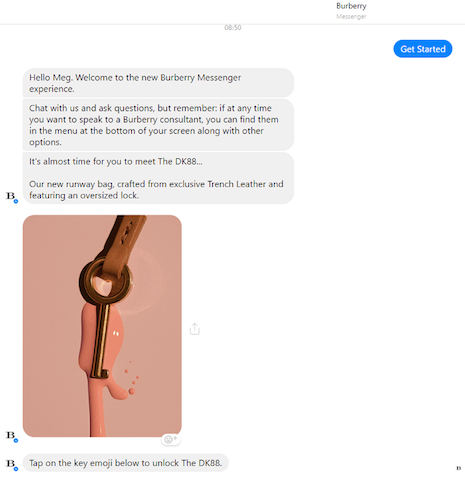 Burberry's got a lock on the bot
Burberry's got a lock on the bot Target versus Prada - customer demographic
Target versus Prada - customer demographic Monitoring the range of products reveals consumers’ preferences, gender breakdown and location of discussions
Monitoring the range of products reveals consumers’ preferences, gender breakdown and location of discussions Demonstrating the range of emotions over a set time period
Demonstrating the range of emotions over a set time period Todd Grossman is CEO for North America at Talkwalker
Todd Grossman is CEO for North America at Talkwalker